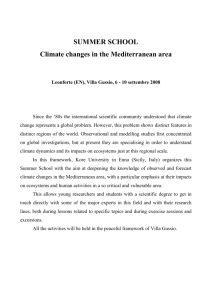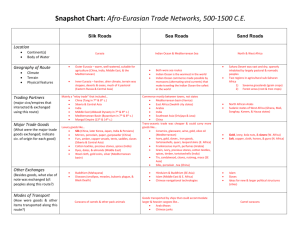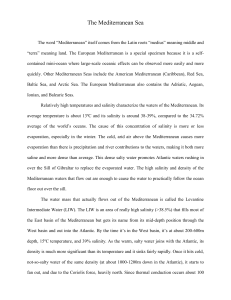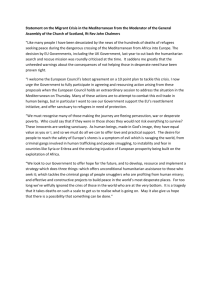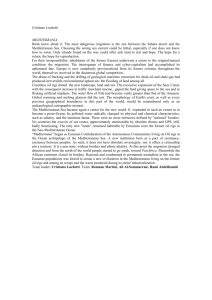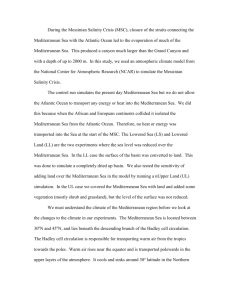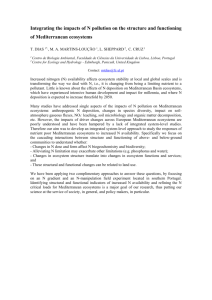Global warming inducing “Tropicalization” of the
advertisement
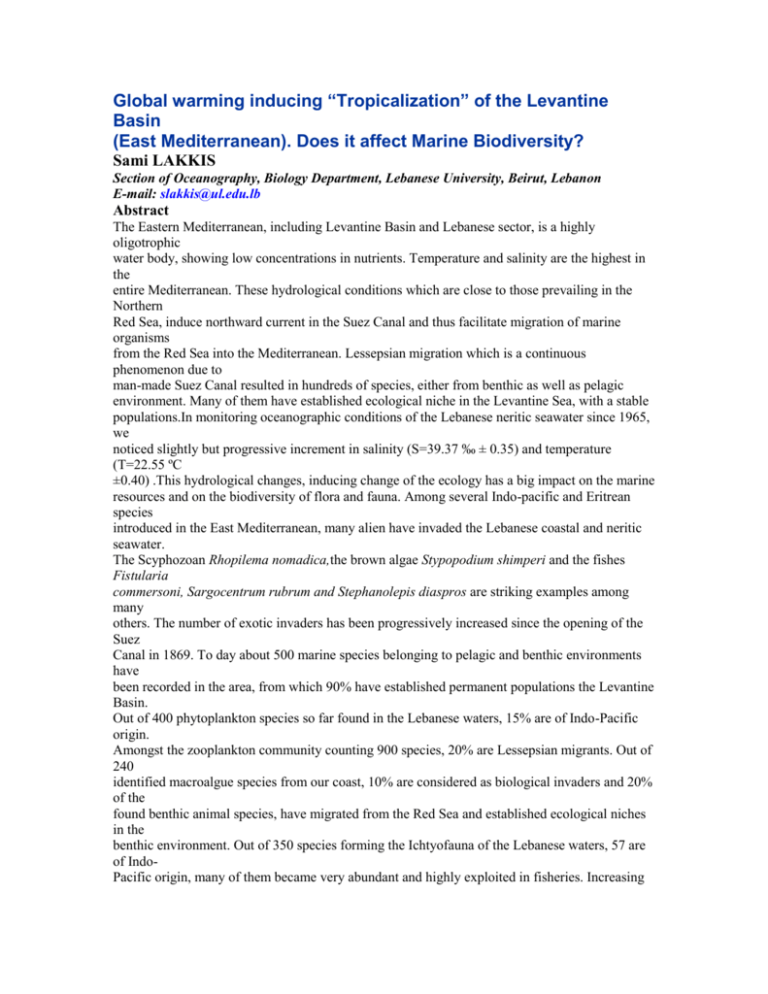
Global warming inducing “Tropicalization” of the Levantine Basin (East Mediterranean). Does it affect Marine Biodiversity? Sami LAKKIS Section of Oceanography, Biology Department, Lebanese University, Beirut, Lebanon E-mail: slakkis@ul.edu.lb Abstract The Eastern Mediterranean, including Levantine Basin and Lebanese sector, is a highly oligotrophic water body, showing low concentrations in nutrients. Temperature and salinity are the highest in the entire Mediterranean. These hydrological conditions which are close to those prevailing in the Northern Red Sea, induce northward current in the Suez Canal and thus facilitate migration of marine organisms from the Red Sea into the Mediterranean. Lessepsian migration which is a continuous phenomenon due to man-made Suez Canal resulted in hundreds of species, either from benthic as well as pelagic environment. Many of them have established ecological niche in the Levantine Sea, with a stable populations.In monitoring oceanographic conditions of the Lebanese neritic seawater since 1965, we noticed slightly but progressive increment in salinity (S=39.37 ‰ ± 0.35) and temperature (T=22.55 ºC ±0.40) .This hydrological changes, inducing change of the ecology has a big impact on the marine resources and on the biodiversity of flora and fauna. Among several Indo-pacific and Eritrean species introduced in the East Mediterranean, many alien have invaded the Lebanese coastal and neritic seawater. The Scyphozoan Rhopilema nomadica,the brown algae Stypopodium shimperi and the fishes Fistularia commersoni, Sargocentrum rubrum and Stephanolepis diaspros are striking examples among many others. The number of exotic invaders has been progressively increased since the opening of the Suez Canal in 1869. To day about 500 marine species belonging to pelagic and benthic environments have been recorded in the area, from which 90% have established permanent populations the Levantine Basin. Out of 400 phytoplankton species so far found in the Lebanese waters, 15% are of Indo-Pacific origin. Amongst the zooplankton community counting 900 species, 20% are Lessepsian migrants. Out of 240 identified macroalgue species from our coast, 10% are considered as biological invaders and 20% of the found benthic animal species, have migrated from the Red Sea and established ecological niches in the benthic environment. Out of 350 species forming the Ichtyofauna of the Lebanese waters, 57 are of IndoPacific origin, many of them became very abundant and highly exploited in fisheries. Increasing temperature and salinity and the reduced marine resources induced certain “Tropicalization” of the Levantine Basin, enhancing followed some ecological changes of marine ecosystems. This tropicalization of the marine environment is due, not only to anthropic activity traduced by the opening of Suez Canal and the building of Aswan High Dam, but also to climatic change inducing global warming. Key-words: Levantine Basin.Tropicalization.Ecological change.Biological invasion.Biodiversity. INTRODUCTION The Levantine Basin in the East Mediterranean is a semi-closed isolated sea, connected only with the Red Sea through the Suez Canal since 1869. After this date, the east Mediterranean became the subject to biological invasion of exotic Indo-Pacific organisms, either of pelagic or benthic forms. The “Lessepsian” migration, either as active or passive process did not exist before the opening of the canal. It increased progressively with the decreasing salinity of the water canal that dropped from 70‰ at lake Timsah to 42‰ in the entire canal. The canal pathway constituted at the same time a link and a barrier to the marine organisms (Kimor,1972), 2 allowing many pelagic and benthic species of tropical species to invade the Mediterranean, reaching about 400 during the seventies (Por,1978) . This number has been increased afterward following the deepening of the canal and the functioning of Aswan High Dam in 1965, which regulate the Nile River and facilitate the migration through the canal enhancing the northsouth direction current. The increasing invasion intensity noticed during the last four decades is due not only to the man-made activity traduced by the Suez Canal and Aswan High Dam, but also to the global warming inducing certain “tropicalization” of the East Mediterranean. Such phenomenon has created some hydrological changes, enhancing ecological changes of the entire Levantine Basin ecosystem, particularly the increasing temperature and salinity and decreasing of nutrient concentration. Invading tropical species in the East Mediterranean are of two categories: established and aliens. The established are those who adapted themselves to the new marine environment in forming permanent populations or ecological niches; whereas the aliens are those which appear occasionally or temporary in high abundance during certain periods and disappear suddenly after creating certain disturbance among communities. In addition to the direct migration through the canal pathway, there are other means in introducing species, particularly by the water ballast for the pelagic forms and larvae and the anti-fouling benthic organisms attached on the hull of cargo. Commercial transport of living marine organisms for aquaria and decoration contribute also to the introduction of exotic organisms. Few species survive in pursuing their migration north-westward to the Galicean, Aegean, Ionian and Adriatic seas; some of them succeed to reach the western Mediterranean. Biological invasion which is partly the consequence of this ‘tropicalization” may have certainly an impact on the biodiversity of native species. Out of 650 fish species inhabiting the Mediterranean, 90 species representing 56 families are recent arrivals, either from the Atlantic and from the Red Sea; from which about 65 of IndoPacific origin (Golani et al.,2002). From 350 decapods known from the Mediterranean, 60 are newcomers, from which 37 have established permanent populations in the Levantine Basin (Galil et al., 2002). Regarding the Molluscs, Zenetos et al., (2003), have listed 137 invaders, mostly of Eritrean and Indo-Pacific origin. Scarcity of data on alien species in the Levantine Basin is due not only to the lack of specialists, but also to the little frequency in sampling material and in the taxonomic study. During the last decades, several plankton groups were analyzed and many Lessepsian migrants were recorded, namely in phytoplankton (Lakkis & Novel-Lakkis,1981;1985), Hydromedusae and Syphomeduzae (Goy et al.,1991), Copepods (Lakkis,1971,1980,1976b,1984,1990), Ichtyoplankton (Lakkis and Zeidane,2003),Cladocerans, Siphonophores, Appendicularians, Chaetognates, Amphipodes,Crustacean larvae, etc… In this paper attempt is made to review the biodiversity of the area focusing on the increasing number of invading species during the last four decades of survey, and their impact on the biodiversity. MATERIAL AND METHODS Long-term survey during 1965-2004, including the hydrology, pelagic and benthic environments was carried out along the Lebanese coast (Levantine Basin, East Mediterranean). Monthly and seasonal cruises and field trips were made for in coastal and neritic waters for biological sampling and hydrological data in the coordinates Several stations were fixed Plankton sampling series were carried out since 1965 in monthly, seasonally or occasionally cruises, along 3 with hydrological data at several stations along the coastal and neritic Lebanese waters coordinates33º 42’-34º 28’ N and 35º 27’ N-35º 31’ E (Fig.1,). Hydrological data were provided including temperature, salinity, dissolved oxygen, phosphates, nitrate, PH, chlorophyll-a, water transparency, and zooplankton biomass content. Biological data enclosed phyto and zooplankton, zoobenthos, phytobenthos and fisheries. (Lakkis, 2001; Lakkis et al.,1996). Fig.1:Location of sampling stations along the coast of Lebanon; squared spots for pelagic stations,cross spots: coastal stations. The dotted line indicates isobaths of the narrow continental shelf . The insert shows the general surface circulation current in the East Mediterranean. RESULTS Seasonal and multi-decadal fluctuations of hydrology Hydrobiological conditions of Lebanese seawaters are characterized with two annual thermohaline phases: a cold water winter phase (December-March) and a warm water phase during hot and dry summer (June-November) (Fig.2). A short inter-season in April-May separates the two phases. During the cold phase a freshwater outflow from runoff and rivers keeps low salinity in coastal waters and moderate values at offshore (39.25-39.30‰). Homothermic conditions in the whole water column keep the temperature at its lowest annual 4 average (16-18ºC). During the hot and dry phase, the surface temperature increases to reach the maximum of 30ºC in August .Water layer stratification is accompanied with a heavy forming thermocline between 35m and 75 m. Salinity increases up to a maximum of 39.75‰ at the surface because of the strong evaporation, the lack of precipitation and the shortage of freshwater input from rivers. In spring inter-season in April-May, moderate temperature and salinity are suitable for development of phytoplankton standing crop followed with zooplankton development. The general circulation pattern along the coast of Lebanon is prevailed in northward direction during most of the year, in keeping with the general counter clockwise gyre of the Eastern Mediterranean. This current is locally modified by the configuration of the coastline and the topography of the narrow continental shelf. The result of this is a series of clockwise directed eddies and small gyres associated with bays and headlands as well as with numerous submarine canyons incised in the continental shelf. Multiannual fluctuations during the last four decades has show an increasing trend in temperature (Δ~0.40 ◦C) and salinity of (Δ 0.35‰), is due not only to the stop of the Nile flood but also to the global warming affecting the East Mediterranean . (Fig3). Fig.2:Monthly variations of temperature and Fig.3:Multiannual trend of temperature salinity at an offshore stations during 1991,92,93. and salinity during 1970-2004. The annual range of surface temperature between the minimum average in February and maximum is about 14◦C. The thermocline starts to form in June-July between the layers 35-75 m and to reach highest intensity in August-September. Inversely, in winter, homothermal conditions are formed in winter (January-March) with the mixing water masses and turnover of water layers; they are traduced by the isothermal curve between the surface and the depth (Fig.4). As far as the salinity is concerned, the annual range is very small, it varies at the surface and offshore seawater between 39.25‰ in winter and 39.75‰ in summer because of shortage of freshwater input and the intense evaporation. The vertical evolution of the salinity is much less pronounced tha temperature, at 200 m depth the salinity average remain constant between 30.35 and 39.38‰ (Fig.5). Monthly changes pattern of phosphates and nitrates are similar with a maximum concentration rate in February-March and a minimum in spring-summer corresponding to the maximum development of phytoplankton cells which uptake the nutrients for growth (Fig.6). Multidecadal fluctuations show a little increasing trend, whereas for phosphate, the trend is in slight decrease during the last decades (Fig.7). 5 Fig.4.Vertical distribution of the temperature during Fig.5.Vertical distribution of salinity during 4 months of the year 2002. four months of the year 2002 . Biodiversity and invasion of Planktonic species Marine plankton of Lebanese waters is of Atlanto-Mediterranean temperate type, with certain subtropical affinity. Most of planktonic groups and species inhabiting the temperate Atlantic and west Mediterranean are present in the eastern basin including Levantine sea and Lebanese sector. Comparing multiannual fluctuations of zooplankton, expressed as biomass, and phytoplankton as chlor.-a, we notic decreasing trend during the last four decades (Fig.8). Fig.6:Seasonal variations of phosphates and Fig.7: Multi-decadal trend of nitrates (increase), nitrates as compared to chlorophyll-a at the and phosphate (decrease) in Lebanese seawater surface of water at one offshore station in 2002. ( integrated annual averages ). Phytoplankton About 400 taxa in phytoplankton sub-community are found in Lebanese coastal and neritic waters belonging to the two major groups: the Diatoms and Dinoflagellates; few species of Silicoflagellata and Ebriidae are also present. Out of 160 Diatom species, 22 are of Indo-Pacific origin, introduced through the Suez Canal; 75% of them have adapted to the East Mediterranean environmental conditions and established populations in the Lebanese seawater, the others are casuals and doubtful. The major introduced species belong to genera Biddulphia and Chaetoceros. From 232 Dinoflagellates found in our waters, 15% are of tropical forms and 90% of them have established stable 1970 1975 1980 1985 1990 1995 2000 2005 0 0.05 0.1 0.15 0.2 0.25 0.3 0.35 0.4 Nitra te & Phospha te (mM/l-1) PO4 NO3 JFMAMJJASOND 0 0.1 0.2 0.3 0.4 0.5 0 0.05 0.1 0.15 0.2 0.25 0.3 0.35 0.4 NO3 PO4 Chlor-a PO4/NO3 (μM.l-1) Chlor.-a (mg/m3) 6 populations, the 13 other aliens are casuals. The major introduced species belong to genera Ceratium19 species, Protoperidinium 5, Dinophysis 3, Ornithocercus 3, etc.. ( Fig.9;Table 1). Fig.8: Multi decadal decreasing trend of phytoplankton Fig.9: Progressive increasing number of and zooplankton during the last four decades. phytoplankton species along with number of invaders during1970-2005. Table 1-Phytoplankton Diversity and invasive species in Lebanese seawaters. Major Taxa Nb. of species Found in Lebanon Nb.of Invasive species % of invasive Species DIATOMEA 160 22 14 Chaetoceros 33 4 12 Biddulphia 16 10 62 Pseudo-Nitzschia 7 2 28 Bacteriastrum 5 1 20 Others 82 5 39 DINOPHYCEAE 230 35 15 Ceratium 54 19 35 Protoperidinium 32 5 16 Dinophysis 28 3 11 Gonyaulax 9 2 22 Ornithocerecus 7 3 43 Amphisolenia 6 1 17 Prorocentrum 11 ? ? Others 130 2 16% Zooplankton From about 1000 taxa found in our waters, 30% are in common inhabiting the Red Sea and the Mediterranean, and more than 15% are Lessepsian migrants, from which 75% have established populations in the Levantine Basin ( Figs.10,11); the other being aliens, casual or doubtful. Few from those invaders have succeeded to transgress towards the Aegean, Ionian, Adriatic seas and even to western Mediterranean regions. (Pancucci-Papadopoulou et al.,2005; Sciberras & Schembri,2007). 1965 1970 1975 1980 1985 1990 1995 2000 2005 0 0.1 0.2 0.3 0.4 0.5 Chl.a (mg/m3) 0 0.2 0.4 0.6 0.8 1 1.2 1.4 Zoo Biomass ( cc/m3) 7 Fig.10: Number of invading zooplankton sprcies Fig.11:Progressive increasing number of in the East Mediterranean invading tropical zooplankton species The Tintinnids represent major group in the microzooplankton. They play an important role in the pelagic food web and in microbial feeding loop. Out of 141 species found in our waters, 35% are Lessepsians from the Red Sea and Indian Ocean. From the 45 introduced species, 18 are established and the remaining 32 are casuals or doubtful. Fig.12: Increasing number of introduced Fig.13:Evolution of invading tropical fish species Indo-Pacific mollusc species in the Levantine in the Levantine Basin during the last four decades Basin during the last four decades (data from as compared with the increasing found native Zenetos et al.,2003). Species (data from Golani et al., 2002). Out of 67 Hydromedusae species found in Lebanese coastal seawaters, 8 are of IndoPacific origin. Among the 5 Scyphomedusae present is our waters, 2 are Lessepsians:Cassiopea andromeda and Rhopilema nomadica (Galil et al.,1990). This stinging venomous species shows heavy aggregation in coastal waters during July and August, creating damage to the fishermen in their nets and fear to the swimmers. This harmful jellyfish overcame and replace the autochtonous and inoffensive species Rhizostoma pulmo. Within Siphonophores, 23 Calycophores and 5 Physonectes species inhabit Lebanese seawaters from which 17 are tropical invaders, 12 calycophores and 5 physonectes. From those 12 invaders (8 +4 Euphausiacea Thaliacea Cladocera Scyphozoa Pteropoda Chaetognatha Appendicularia Amphipoda Siphonophora Hydromedusa Ichtyoplankton Decapod larvae Tintinnids Diatoms Copepoda Dinoflagellates 0 50 100 150 200 250 300 Nb.Autochtonous sp. Nb.of Invasive sp. 1965 1970 1975 1980 1985 1990 1995 2000 2005 YEARS 40 60 80 100 120 Cumulative Nb.of Exotic Zoopl.species 800 850 900 950 1000 1965 1970 1975 1980 1985 1990 1995 2000 2005 YEARS 25 35 45 55 65 75 Cumulative Nb.of Exotic fish species 200 220 240 260 280 300 Cumulative Total Nb.of found species 8 respectively) have established permanent populations; the most common are: Diphyes dispar, Muggiaea atlantica, Sphaeronectes gracilis, Nanomia bijuga, Agalma elegans, A.okeni and Halistemma rubrum. However the four dominant siphonophores in the area are native species: Eudoxoides spiralis, Lensia subtilis and Sphaeronectes irregularis. With 175 pelagic Copepod species, this group is the most important zooplankton group in Lebanese waters (Lakkis, 1984, 1990). 55 species are Lessepsians: 23 calanoids and 32 cyclopoids, from which 17 and 18 respectively have established stable population, the remaining 20 are aliens or questionable species. Biodiversity and invasion of benthic and nektonic species Macroalgae of the Lebanese coastal water show high species and taxonomic diversity. All Mediterranean groups are present and most Atlanto-Mediterranean species inhabit the Levantine Basin. In addition to those, several exotic tropical species were introduced in the area where they form ecological niches and permanent populations. A total of 241 taxa were identified and occupying areas from the supralittoral level, intertidal, infra-littoral and circalittoral zone down to -60 m; 34% are in common with the Red Sea and 10% are established invaders of Eritrean and Indo-Pacific origin. They belong to Cyanophyceaea (25 species, 2 invaders), Chlorophyceaea (60 and 8), Phaeophceaea (32 incuding 6 invaders) and Rhodophycea (120 including 8 invaders) (Lakkis & Novel-Lakkis, 2000). The major invading species in the Levantine including Lebanese coastal waters are: -Ulvophyceae :Acetabularia parvula, A.moebii,caulerpa racemosa,C.scalpelliformis,Derbesia boergesenii. -Fucophycaceae: Stypopodium schimperi. -Rhodophyceae:Acanthophora delilei, Asparagopsis taxiformis,Hypnea hamulosa,Liagora farinose,Lophocladia lallemandii. -Phanerogams: Halophila stipulacea. These invaders have occupied ecological niche and mixed with other native species; some of them overcame local species and dominate the community, namely Stypopodium, Hypnea, Liagora,etc.. The number of Decapods known in the Mediterranean is about 350, from which 59 species (+ 1 stomatopod) are of Indo-Pacific origin and 37 from those have established permanent populations, the others are considered as aliens. Molluscs constitute an important component of the marine community, making up between 15 and 25% of benthic macrofauna. Among the 1800 native mollusk species so far mentioned in the Mediterranean, 137 are exotic forms, from which 85% are tropical of Eritrean and Indo-Pacific origin (Zenetos et al.,2003). 60% of the newcomers were discovered during the last four decades (Fig.12). A total of 650 Fish species are recorded to date in the whole Mediterranean; from which 90 species representing 56 families are newcomers from distant seas, including 57 species Lessepsian migrants of Eritrean and Indo-Pacific origin. From these invaders, 40 are established in the Levantine Basin and 17 are aliens. The remaining 33 are introduced mostly from the Tropical Atlantic and one species from the Black Sea (Golani et al.,2002) (Figs.13,14,15) . 9 Fig.14: Multi-decadal number trend of major marine Fig.15: Percent of invaders in four major invading species in Lebanese seawater during groups in Lebanese seawater. last four decades. DISCUSSION AND CONCLUSION The Levantine Basin is situated in a subtropical region where hydro-climatic conditions are close to those prevailing in the Red Sea, namely high seawater temperature and salinity and heavy oligotrophy. So many species inhabiting the Levantine Basin show certain tropical affinity. During the geological periods and millions years before opening of Suez Canal there was a certain link between the Mediterranean and other oceanic basins. In the Miocene, some connection linked the Mediterranean to Indian Ocean through Mesopotamia, to North Atlantic through the Rhone-Seine depression and to tropical Atlantic through Moroccan Rif. After the Messinian hypersaline crisis and the different glaciations, the Mediterranean settle down actual configurations and the fauna and flora types reflect this long geological history. Many endemic species living in the Mediterranean inhabit equally the Red Sea and Indo-Pacific or the temperate and tropical Atlantic. In this case and after the opening of Suez Canal and the launching of the migration process, there was a big invasion of hundreds Indo-Pacific and Eritrean species in the East Mediterranean. We can’t distinguish between a native species and an exotic invader. In any case the opening of the Suez Canal was an important event of great biological importance inducing changes in the hydro-biology on the East Mediterranean, particularly on the east Levantine ecosystem with strong impact on the marine biodiversity. On the other hand, this manmade event has contributed to enhance certain “tropicalization” of the levantine ecosystem. Furthermore, the regulation of the Nile by the Aswan High Dam resulting in the stop of the flood has contributed to strengthen this “tropicalization” which induce and increase the biological invasion process. In comparing between the hydrological conditions prevailing in the Levantine Basin and those of the Red Sea, namely the high salinity and temperature, the heavy oligotrophy and low primary productivity rate. The first reliable record of “Lessepsian” fish and other marine species in the Levantine sea date from 1902 (Golani et al,2002. Biological survey were rare during this period and we had to wait until the fifties of last century to have 26 fish species records of Indo-Pacific species in 1965, 38 molluscs, 45 zooplankton and 41 crustaceans.( Fig.14). During the last four decades of our survey, i.e. from 1965 up to date we noticed increasing introduced Lessepsian species as follow: phytoplankton 56 invaders, zooplankton 110, mollusks 122, fish 60, etc… This Macroalgae Ichtyofauna Mollusca Crust.Decapods 0% 20% 40% 60% 80% 100% % of Autochtonous sp. % of Invasive sp. 10 geometric increment of the invasion is due, not only in the progress of the sampling and taxonomical analysis techniques, but also to the global warming of the seas, following the general climate change observed worldwide during the last decades. Is there any impact of this biological invasion on the biodiversity of marine ecosystem? It is well known that there are three different kind of newcomer invaders: the established which adapt to the new environment in establishing permanent populations, the alien which is recorded once or twice even in high number and disappear without keeping population, the third kind is the doubtful or questionable invader that we are not sure whether it establish population or not. The ecological adaptation which involve nutritional competition between species, successful reproduction, development and succession of several generations, may take long-time, may be years to be achieved. In any case, the survey of the biological invasion needs long time of assiduity and continual observations to be confirm the established invader or the aliens.. The impact of the newcomers on the biodiversity is observed through the abundance and even dominance of certain species in the community. The striking example is observed in the fish species Stephanolepis diaspros, Sargocentron rubrum, Siganus rivulatus, S.luridus and recently Fistularia commersonii. These species and many other established invaders, became very abundant, even dominant, are exploited in fisheries. The same example can be mentioned within brown algae Stypopodium shimperi which invade large coastal areas, the stinging and harmful jellyfish Rhopilema nomadica which create the fear of swimmers and damage to the fishermen nets. The hundred of invaders which established their ecological niches in the area show a negative impact on the biodiversity of local species. They disturb the development of many populations in occupying vital space and show competition the food with many native species, in such a way that the biodiversity could be reduced or endangered in creating certain ecological imbalance. The list of some plankton alien species reported from Lebanese seawater in this study includes a total number of 189, including 57phytoplankton and 132zooplankton; from those 105 have established populations in the Lebanese seawaters, enclosing 9 diatoms, 19 dinoflagellates, 18 tintinnids, 8 hydromedusae, 4 shyphomedusae, 12 siphonophores, 17 calanoid copepods and 18 cyclopoids. The remaining species are doubtful records, either because of misidentification or insufficient sampling frequency. Introduction of planktonic aliens species in the Levantine Basin are still going on and the increasing process was observed after the deepening of Suez Canal and the construction of Aswan High Dam.It is well known that the introducing species arrive in the Easterm Mediterranean coast not only through the canal pathway northward current, but also by the mean of ballast of cargo and attached on the hull of the boats. The import of commercial decorating and exotic aquarium marine organisms into the Mediterranean is also a major factor of transport tropical species into the Mediterranean. Furthermore, the relative number of introduction and migration pelagic organisms is more important than the benthic onces, and their distribution the drifting currents and water mass movements is more pronounced. On the other hand, several Atlantic species either from temperate or from tropical regions may reach the Mediterranean through the Gibraltar strait current and many of those can reach the eastern Mediterranean. It happens that the same thermophile aliens may occur in the Western and Eastern Mediterranean, also from different ways of migration. This is the case of same planktonic species either phyto or zooplankton mentioned in both the regions (Gaudy; 1962b; Razouls, 1972; Lakkis, 1982). Regarding the migration from the Red Sea, which is more important, is demonstrated by several authors (Halim,1970;Kimor,1972; Dowidar,1976; Lakkis and Novel-Lakkis,2000; Zenetos et al.,2003;Galil et al.,2002;Golani et al., 2002; Lakkis et al.,2002) .Worth to notice that 11 during the last four decades, and after the functioning of Aswan high dam, hydroclimatic changes and global warming have created close resemblances in the hydrology and ecology between the Red Sea and Levantine Basin (Halim,1975), namely: increasing of salinity, temperature and shortage of nutrients . These conditions have generated some ecological change in coastal marine ecosystem traduced by decreasing planktonic production (Fig.5), increasing exotic migration which affect the Levantine marine biodiversity (Lakkis et al., 1996) and decreasing fisheries. On the other hand a review of the composition of the plankton in the Red Sea and Levantine Basin has shown that about 30% of planktonic species equally inhabit the two marine environments (Halim, 1969; Lakkis, 1980). The link between the Mediterranean and other oceans through the geologic era is well known.During the Miocene some marine basins linked between Indian Ocean and the Tethys, previous Mediterranean Sea, through the Mesopotamia to the North Atlantic and to the Tropical Atlantic through the Morocan Rif. After the hypersaline crisis and the different glaciaciation, the Mediterranean took its actual configuration. The types of the present fauna reflect this longue geologic period by the occurrence of same relict species in the Mediterranean and the Indo-Pacificomposition of East Mediterranean fauna and flora prior the opening of the Suez Canal. For this reason we can’t confirm whether the present tropical species are aliens or relict of the Sea of Tethys. Although several species of tropical affinity occurring in our seawaters are not lessepsian migrants; they may be relicts of the Miocene period. More than 50% of the Levantine planktonic fauna are cosmopolitans and worldwide distributed in the three oceans, and only 15% of this fauna occur in the Atlantic (Goy et al., 1991). The big gap in the information about the presence of exotic introducing species in the East Mediterranean is that we do not have data on the As long as the Lessepsian migration is a continuous process, and the “tropicalization”marine ecosystem is going on and affecting the biodiversity, the list of aliens remains uncomplete. It is suggested that this phenomenon should be monitored permanently, not only in the Eastern Basin, but also in the all the Mediterranean regions. This can be made in coordination with different specialists in the concerned countries or even through a pilot project involving all interested people. Without this joint research work, it is not possible to edit a complete CIESM Atlas of exotic planktonic species in the Mediterranean. REFERENCES Dowidar M.N., 1976.The Phytoplankton of the Suez Canal..Acta Adriatica XVIII, 1/23: 239-275 Galil B., Froglia C. and Noël P.,2002. Atlas of Exotic Species in the Mediterranean` Vol.2. Crustaceans:decapods and stomatopods [F.Briand Ed.], 192 pages.. CIESM Publishers,Monaco] Galil B.S., Spanier E., Ferguson N W.W.,1990. The scyphozoans of Israel, including two Lessepsian migrants new to the Mediterranean. Zoologischen .Mededelingen,64:95-105. Gaudy R.,1962b. Sur la presence à Marseille d’espèces planctoniques indicatrices d’eaux d’origine atlantique. Rapp.Comm.int.Mer Médit.,38, 17(2) :539-543. Golani D., Orsi-Relini, L., Massuti, E., and Quignard , J.P.,2002. Atlas of Exotic Species in the Mediterranean Vol.1. Fishes.. [F.Briand Ed.],256 p.. CIESM Publishers,Monaco] Goy J., Lakkis S.,and Zeidane R., 1991.Les méduses (Cnidaria) des eaux libanaises. Ann.Inst.Océanogr., Paris, 67,2:99-128. Halim Y.,1969.Plankton of the Red Sea. Oceanogr.Mar.Biol.Ann.Rev., 7:231-275. Halim Y., 1970. Microplancton des eaux égyptiennes. III. Espèces indo-pacifiques ou érythréennes à l’extrême nord du Canal de Suez. Journées Etudes Planctonol.,CIESM,Monaco :57-59. Halim Y., 1975 . The Nile and the East Levantine sea: past and present . Rec.Res. in estuarine biology. R.Natarajian (ed.).Hindustan Publishing Corp. (I). Delhi,India: 76-84. 12 Kimo B., 1972. The Suez Canal as a link and a barrier in thr migration of planktonic organisms. Isr.Journ.of Zool., 21:391-403 Lakkis S.,1971a. Contribution to the study of Zooplankton of Lebanese neritic seawater . Mar.Biol.11,2: 138-148. Lakkis S., 1971b. Seasonal variations in abundance of pelagic Copepods in Levantine Basin off Beirut. Thalassia Jugoslavica, 7, 1:159-170. Lakkis S.,1980. A comparative study of t he plankton in the Red Sea and Lebanese waters. Proc.Symp.Coast.Mar.Env.Red Sea, Gulf of Aden and Tropical W. Indian Ocean (Khartoum), Vol. II: 541-559.UNESCO-ALECSO. Lakkis S.,1982. Contribution to the study of Neritic Ecosystem of Lebanese waters ( East Mediterranean) with reference to plancton Ecology . Thèse Doctorat d’Etat ès-Sciences Naturelles ( Marine Biology), University Paris 6 : 505p Lakkis S.,1976. Consideration on the distribution of pelagic Copepods in the Eastern Mediterr. off Lebanese coast .Acta Adriatica,XVIII,3:41-52. Lakkis S.1984, On the presence of some rare Copepods in the Levantine Basin. Crustaceana, Suppl.7:286-304. Lakkis S.,1990. Composition,diversité et succession des copépodes planctoniques des eaux libanaises(Médit. Orientale). Oceanologica Acta, 13,4:489-502. Lakkis S., and Zeidane, R.,2003. Exotic species and Biodiversity of Plankton Community in Lebanese waters. Workshop on Aquaculture, fisheries and Environment.Tichrine University,Lattakia, Syria, 29-30 April 2003. Lakkis S., Bitar G., Novel-Lakkis V. And Zeidane R., 1996. Etude de Diversité Biologique du Liban.Flore et Faune Marines .PNUE & Min. Agric. Beyrouth,Liban, Publ.No 6:123p Lakkis S., & Novel-Lakkis V.,1979. Phytoplankton of Lebanese coastal waters : floristic and ecological survey Rapp.Com.int.Mer Mdit.,25/26:77-79. Lakkis S.., & Novel-Lakkis V.,1981. Composition, annual cycle and species diversity of the Pytoplankton in Lebanese coastal water . Journal of Plankton Research, 3,1:123-136. Lakkis S.& Novel-Lakkis V.,1985. Les Tintinnides (Tintinnina) des eaux côtières libanaises: composition , distribution et cycle annuel. Lebanese Science Bulletin,1,1:43-58. Lakkis S.and Novel-Lakkis, 2000. Importance des Caulerpes dans les peuplements algaux de la côte Libanaise le long de la côte (Bassin levantin,Méditerrannée orientale). Fourth International Workshop on Caulerpa taxifolia (Gravez et al. eds.),GIS Posid. publ.,Fr.:315-327 Lakkis S., Kideys A.E., Shmeleva A, A., Kovalev A.V.,Unal E.,& Zeidane R.,2002. Comparison of Zooplankton Biodiversity among Eastern Mediterranean Basins with particular References to the Alien Species Proceedings of the 2nd Int.Conf.on Oceanography and Black Sea : Similarities and Differences of two interconnected Basins : 821-827 Pancucci M.A., Zenetos A., Corsini –Foka M., and Politou C.Y., 2005. Update of marine alien species in hellenic waters. Medit. Mar.Sci. ,6/2,2005,147-158. Por F.D.,1978. Lessepsian migration-The influx of Red Sea biota into the Mediterranean Sea by way of Suez Canal viii+228 p. Springer, Berlin. Razouls C, 1972. Estimation de la production secondaire (Copépodes pélagiques) dans une province néritique méditerranéenne (Golfe de Lion). Thèse Doct.d’Etat, Paris 6 :301 p. Sciberras M. and Schimbri P.G., 2007. A critical review records of alien marine species from the Maltese Islands and surrounding waters (Central Mediterranean). Medit.Mar.Sci.,8/1:41-66. Zenetos A., Gofas S., Giovanni R. & Templado J., 2003. Atlas of Exotic Species in the Mediterranean` Vol.3. Molluscs [F.Briand Ed.], 376 pages. CIESM Publishers,Monaco] .

